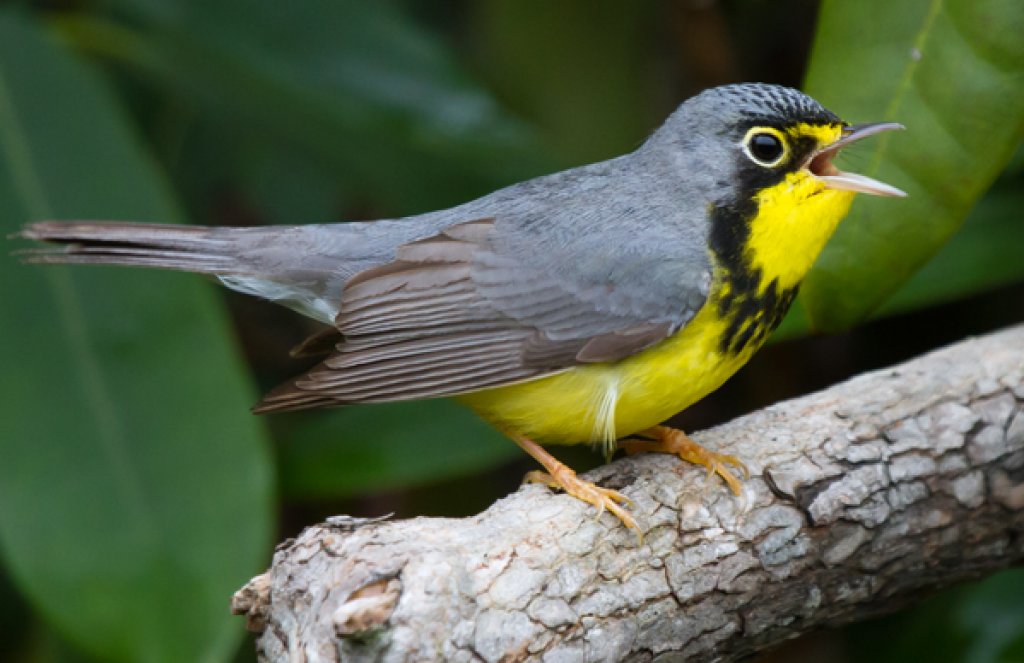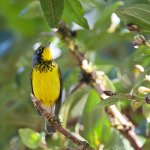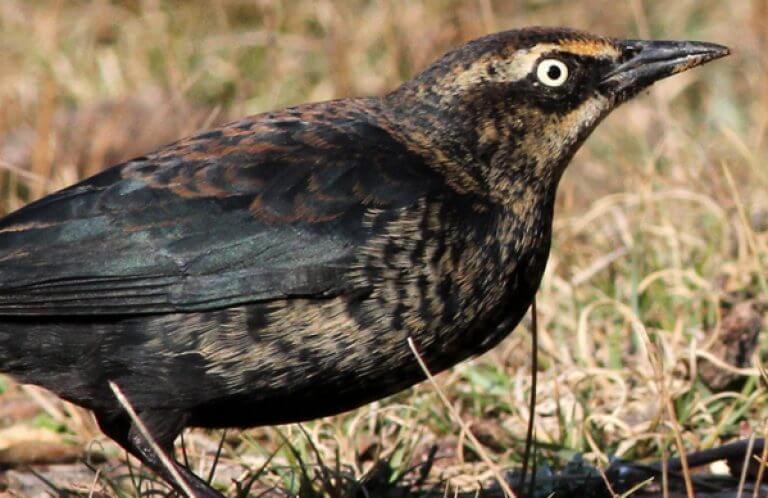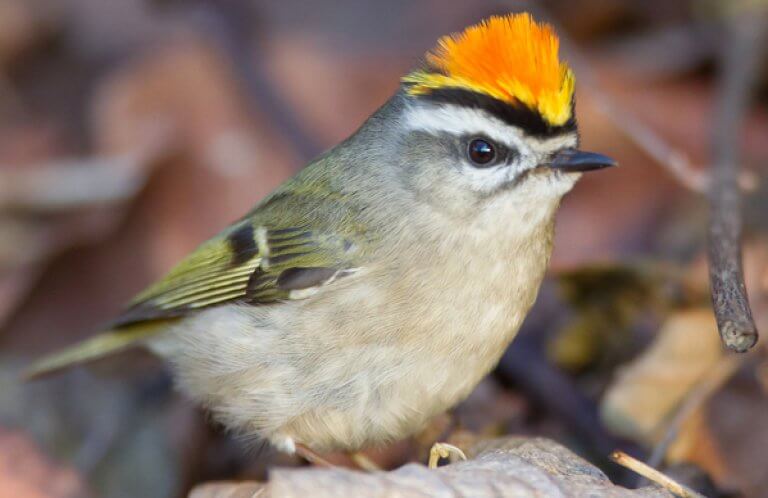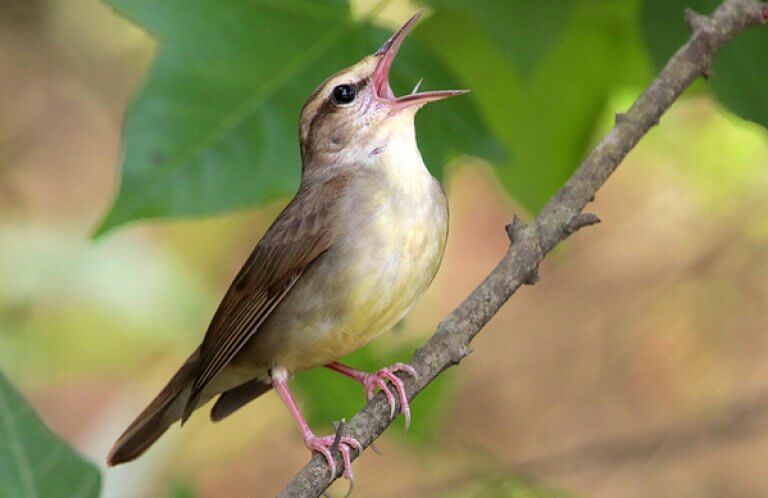About the Canada Warbler
The lively little Canada Warbler is a bird of thick forest undergrowth, where, like a Swainson's or Kentucky Warbler, it is more often heard than seen. A good look reveals a bird with blue-gray upperparts, a bright lemon-yellow throat and chest, and, most notably, a band of contrasting black or gray streaks across its breast that gives this bird the nickname the "necklaced warbler."
Male and female Canada Warblers look similar, although the female's plumage is less striking because her necklace and facial markings are grayish rather than black.
The Canada Warbler often catches its insect food in flight, leading to folk names such as Canadian Flycatcher and Canadian Flycatching Warbler. Like the American Redstart, its animated foraging style may include hover-gleaning, aerial sallies, and hopping along branches to nab prey.
Songs and Sounds
The Canada Warbler's song, usually preceded by a short chip, is a rather abrupt-sounding outburst of notes, described by Roger Tory Peterson in his classic Field Guide to the Birds as “chup, chupity, sweet ditchety.” Canada Warblers often sing late into their breeding season, and sometimes even during fall migration. Interestingly, female Canada Warblers sing as well, a characteristic also noted in the closely related Wilson's Warbler.
Listen here:
Breeding and Feeding
The Canada Warbler spends less time on its breeding grounds than do most warblers, being one of the last species to arrive and among the first to depart. Males generally arrive in nesting areas before females. Canada Warbler pairs are seasonally monogamous, with some research showing that pair bonds may persist through migration and even on the wintering grounds.
Once mated, the female Canada Warbler builds a bulky nest of dried plants and mosses on or near the ground. Her mate may supply nest material during the building process. The nest is well-concealed at the base of a stump or in a clump of thick vegetation. The female lays three to five eggs, which she incubates for almost two weeks. Both parents pitch in to feed the hatchlings, which leave the nest after a little over a week. Parent birds continue to feed the young for several weeks after they fledge.
Unfortunately, Canada Warbler nests are frequently parasitized by Brown-headed Cowbirds.

The Canada Warbler's diet consists largely of flying insects such as flies, mosquitoes, moths, and beetles, but this little songbird also dines on spiders, as well as caterpillars and other insect larvae. This species is usually seen foraging low in thick undergrowth and gleaning along lower tree branches. It can sometimes be seen feeding on the ground.
Region and Range
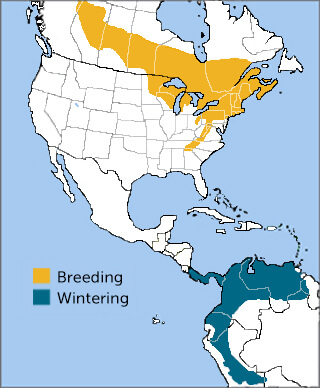
The Canada Warbler nests in dense undergrowth in mature forests, often near the Golden-crowned Kinglet, Rusty Blackbird, and Olive-sided Flycatcher, among others. Its breeding range stretches across central and eastern Canada and into the U.S. in the Great Lakes and Northeast regions, then down along the Appalachian Mountains as far south as Georgia's northern border.
The Canada Warbler is a long-distance migrant, in late summer and early fall moving south by night, often in pairs, to winter habitats mainly in northern South America. These wintering grounds are usually in mid- and upper-elevation forests, and also at shade-coffee farms. Wintering Canada Warblers often join mixed-species flocks with other Neotropical migrants such as Blackburnian, Wilson's, and Cerulean Warblers, as well as resident antbird and tanager species.
Canada Warbler Conservation
Breeding Bird Survey data show a population decline of 3.2 percent per year throughout the Canada Warbler's breeding range, with the greatest declines in the northeastern United States. Partners in Flight includes the Canada Warbler on its Yellow Watch List.

Help support ABC's conservation mission!
Habitat loss caused by forest clearing and fragmentation; over-browsing of the understory by deer; acid rain; and the spread of the Hemlock Woolly Adelgid insect (which kills Eastern Hemlock and Carolina Hemlock trees) have all reduced available habitat. Canada Warblers also face habitat loss in the northern Andes, where a substantial portion of the population winters.
Additionally, many Canada Warblers fall victim to collisions with building glass and communications towers during their nocturnal migrations.
ABC's network of bird reserves across Latin America help provide migration-stopover and winter habitat for the Canada Warbler. Canada Warblers have been spotted at 23 of these reserves, including the El Dorado and El Paujil reserves in Colombia; Tapichalaca, Buenaventura, and Rio Canandé reserves in Ecuador; and Abra Patricia in Peru.
We are involved in a number of large-scale conservation initiatives to protect and recover habitat for migratory birds such as the Canada Warbler, including BirdScapes and Joint Ventures. ABC's Collisions program offers solutions to keep Canada Warblers and other migrating birds safe from collisions.
Get Involved
Policies enacted by the U.S. Congress and federal agencies, such as the U.S. Fish and Wildlife Service, have a huge impact on migratory birds. You can help shape these rules for the better by telling lawmakers to prioritize birds, bird habitat, and bird-friendly measures. To get started, visit ABC's Action Center.
Living a bird-friendly life can have an immediate impact on migratory birds in the United States. Doing so can be as easy as adding native plants to your garden, avoiding pesticides, and keeping cats indoors. To learn more, visit our Bird-Friendly Life page.
American Bird Conservancy and our Migratory Bird Joint Venture partners have improved conservation management on more than 6.4 million acres of U.S. bird habitat — an area larger than the state of Maryland — over the last ten years. That's not all: With the help of international partners, we've established a network of more than 100 areas of priority bird habitat across the Americas, helping to ensure that birds' needs are met during all stages of their lifecycles. These are monumental undertakings, requiring the support of many, and you can help by making a gift today.





































